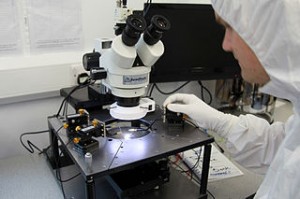Nanomaterials are particles that are between 1 and 100 nanometers in diameter. A nanometer is one millionth of a millimeter. Small as they may be, there is no doubt that the nanotechnology revolution offers great hope for epochal advances in fields such as medicine, electronics, manufacturing, sensor development, energy production, pollution control and many other fields.

Image credit: wikimedia commons User: University of Exeter
According to an article featured on The Conversation, the synthesis of nanoparticles and nanocomposites enables us to move material that is highly insoluble, like gold and silver. This technology can be applied in many spheres, most notably in medicine, for diagnosing purposes. Metal nanoparticles are coated with a protein that is attracted to tumor cells and this allows for easier detection and may even help with treatment.
But is there a dark side to this nano-miracle? Questions have been raised in recent times over the potential negative impacts to the environment and human health.
The change in trans-portability may have adverse effects because it makes the metal easier to absorb.
When manufactured nanomaterals (MNMs) are applied to the land as biosolids-for example, through municipal waste streams-they can accumulate over time. EPA has not devised specific guidelines for disposal of waste nanomaterals and the management requirements are exactly the same as for the material in conventional solid state.
Science is yet to determine the possible environmental risk to terrestrial ecosystem by the use of nanomaterials.
The Australian Therapeutic Goods Administration recently reviewed literature on nanomaterials in sunscreens and labeled it safe for use, whereas an Australian review by CSIRO stressed the lack of knowledge about MNMs in the environment.
Recent study performed by Professor Paul Bertsch, who investigated whether metal and metal oxide nanoparticles could be taken up by, and be toxic to microorganisms, detritivores and plants, showed that metal and metal oxide nanoparticles do accumulate in soils rather than dissolve and can indeed be toxic to microorganisms, plants, nematodes and worms.
The results of the study undoubtedly showed that accumulation of MNM’s in the food chain is a more serious threat than direct exposure, as nanomaterial contaminants build up in food, which upon digestion transfers effectively in the eater’s tissue.
It is fair to say that there are many unanswered questions when it comes to nanomaterials in soils and plants, and because of that we should be very careful when we dispose of waste containing MNMs, but also about how we manage disposal sites.


















